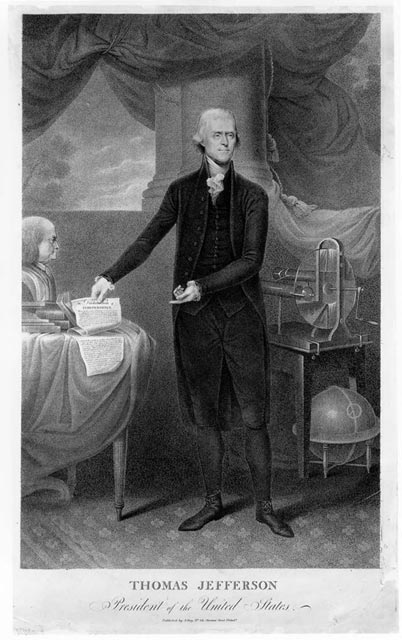Liberty Matters
Jefferson’s Limitations, Perspective, and Evolving Thought

I am grateful to have the opportunity to contribute my thoughts on Jefferson’s faith with Hans Elcholz, Cara Rogers Stevens, and Todd Estes. I have enjoyed reading your contributions and have shared what I believe to be a summary of your essays sharing my personal thoughts on all. Thank you.
Hans Elcholz tackles the ever-present question of Jefferson’s evolving thoughts on slavery, addressing the daunting question why Jefferson did not follow the path of least resistance adopting the belief, like most of his Southern contemporaries, that slavery was “a positive good.” Unquestionably, Jefferson was influenced by the time he lived and the men surrounding him, particularly while he was in Williamsburg at the dawn of revolution. John Adams defined this remarkable period in his letter to Jefferson in 1815, “What do We mean by the Revolution? The War? That was no part of the Revolution. It was only an Effect and Consequence of it. The Revolution was in the Minds of the People, and this was effected, from 1760-1775.” Jefferson began his studies at the College of William and Mary under the tutelage of William Small in 1760. Historians often overlook these pivotal years in Jefferson’s development, and I find this the most significant part of the essay. As Elcholz details, using Jefferson’s Commonplace Book, and recent research by David Thomas Konig and Michael Zuckert that Jefferson’s perspective on property ultimately sided with Lord Raymond’s belief and had no place in the classification of a person. Revolutionary in thought was that “enslavement in all forms was an evil.” That Jefferson teetered between this conviction, and as Elcholz reminds us “went no further than he did” is a question for the ages.[1]
Cara Rogers Stevens likewise addresses Jefferson’s evolving perspective on slavery, similarly, identifying the powerful influences of his teachers in Williamsburg, drawing attention to George Wythe. Jefferson in his opening salvo confronting the institution of slavery politically was spared “humiliation” when the bill “allowing master to manumit their slaves” failed. This point is important in the essay as it gave Jefferson the opportunity to fight another day. Here, Stevens’ work diverges from that of Elcholz examining his efforts in the courts and legislature to effect change. From 1770 when he argued that “every one comes into the world with a right to his own person” and his argument was “thrown out” of the courts, to eight years later when Virginia’s legislature did end participation in the slave trade. Unfortunately, his efforts on behalf of his country to end slavery eventually fell silent and stopped as emancipation proved vinegar in the mouths of the majority of politically powerful Virginians. Eventually, Jefferson used his most powerful tool, education, to shift strategy. This change of approach I found quite interesting but also obvious and to be expected of Jefferson. Jefferson used his only book, Notes on the State of Virginia, to influence the thoughts of a coming generation, and as Stevens writes it did influence future generations including the future Commanding General of the U.S. Army Winfield Scott who “developed antislavery views while reading Jefferson’s notes” while at college in Williamsburg. Putting Jefferson into context, we can see through his eyes that he could have done more but as Stevens reminds us of acted “within the boundaries acceptable at the time.”
Todd Estes brings focus on how Jefferson’s perspective on the U.S. Constitution evolved, a topic with never-ending nuances in Jefferson’s political growth and maturity. Jefferson, like John Adams, was conspicuously absent from the Constitutional Convention. Both were in Europe, Adams serving as our first ambassador to the Court of St. James in London and Jefferson as the Minister Plenipotentiary to the Court of Versailles in France. Receiving news of the adoption of the Constitution by Congress and having copies shared, Jefferson had the opportunity to reflect on the new “Law of the Land” from 3,705 miles away and at a time when, depending upon weather, news traveled at a snail’s pace (6-10 weeks) between the continents. While absent from the ratification debate at home, Jefferson was active in the deliberation and made me recall Adams’ reference how “it is marvellous [sic] how political Plants grow in the shade.” During the period of ratification, Jefferson orchestrated what he could; writing to his revolutionary colleagues he articulated a need for “a declaration of rights.” Jefferson’s views on the Constitution were not bound to party but certainly in the belief that he was right, “I never had an opinion in politics or religion which I was afraid to own” Estes reminds us. What Estes so vividly defines is Jefferson’s lifelong commitment to inalienable rights. It was not political, it was, for Jefferson, undeniable. Returning home and to new and more challenging environments, Secretary of State, Vice President, and President, Jefferson’s evolving views on the Constitution became a political vision that shaped his legacy.[2]
Endnotes
[1] “John Adams to Thomas Jefferson, 24 August 1815,” Founders Online, National Archives, https://founders.archives.gov/documents/Jefferson/03-08-02-0560. [Original source: The Papers of Thomas Jefferson, Retirement Series, vol. 8, 1 October 1814 to 31 August 1815, ed. J. Jefferson Looney. Princeton: Princeton University Press, 2011, pp. 682–684.]
[2] John Adams to Abigail Adams, 14 January 1797, Massachusetts Historical Society
Copyright and Fair Use Statement
“Liberty Matters” is the copyright of Liberty Fund, Inc. This material is put on line to further the educational goals of Liberty Fund, Inc. These essays and responses may be quoted and otherwise used under “fair use” provisions for educational and academic purposes. To reprint these essays in course booklets requires the prior permission of Liberty Fund, Inc. Please contact oll@libertyfund.org if you have any questions.